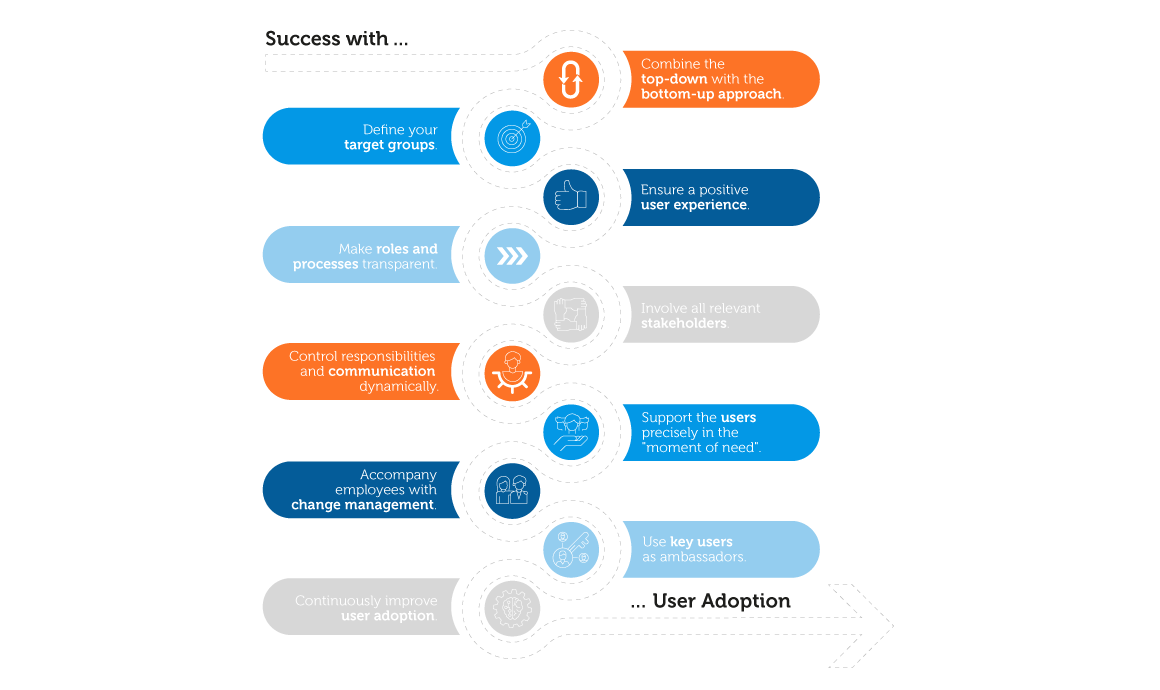Ten tips - how to succeed in user adoption

You can start laying important groundwork as early as the planning stage of an implementation project to ensure your employees adopt the new software and use it successfully. However, surveys show that many companies fail at this task. They take user adoption into account far too late in the process and then unfortunately fail to take it far enough. So it’s no wonder the new tool doesn’t lead to the desired business success in the medium term, and the investment doesn’t pay off.
But how do you achieve high levels of user adoption? There is no cure-all strategy – that much is clear. There are far too many differences between each individual company and project. However, although there is nothing close to a one-size-fits-all solution, there are certainly factors that can help users embrace a new application, and measures that will increase their willingness to adopt it. In the following ten tips, you’ll find out what these are and how you can implement them for your company.
1. Connect the top-down with the bottom-up approach
To ensure successful user adoption, it is important to involve every employee concerned and keep them in the loop throughout the entire process. Depending on the topic and target group, you should pursue a bottom-up approach as well as a top-down one. In other words, avoid imposing everything from above – especially in the case of implementation projects. It is also up to the employees to put theory into practice. For this to work, they should be involved in shaping the measures and, for example, incorporate the challenges that arise for them in day-to-day business into the planning. This way, you are taking a crucial step towards ensuring users accept the new software – and all before the roll-out even begins.
2. Define your target groups
Anyone planning an implementation project should know who their target groups are. Who will be working with the software, and how are these people involved in the processes? To understand the needs of the actual users, the project coordinators have to put themselves in their position. The persona method has proven to be an effective strategy here. It helps you define the target groups as precisely as possible by categorizing them according to certain characteristics, skills and needs. Not only does this give your target groups a face, it also provides the project coordinators with valuable guidance when deriving appropriate measures.
3. Ensure a positive user experience
Make the new functions and processes as simple as possible and follow user experience (UX) guidelines. Implementing new software changes your employees’ workflow, and they have to adapt. Their tasks will require more effort, especially in the beginning, so their workload will initially increase. You should therefore scrutinize old processes and structures in terms of their usability and benefits. Every measure and every simplification is welcome – after all, users should get a sense of achievement very early on and feel that the new solution is making them faster and more effective at what they do.

User adoption - ten steps to success
4. Make roles and processes transparent
The new solution does more than just change the way something is done – it may also redistribute tasks. As a result, some employees will have to give up familiar routines and adopt new workflows and roles. You should proactively oversee these changes and make a point, early on, of answering questions such as: What is the point of the new structure? What changes will come from this – both overall and for individuals? To what extent does the company benefit from this, and what are the advantages for employees? To support a common understanding and make new responsibilities visible, the new processes and roles should be transparent for everyone in the organization. If employees are to be fully won over, they should experience the advantages of the new processes and roles in their day-to-day work quickly – in the form of faster, more reliable workflows, reduced error rates and increased efficiency.
5. Involve all relevant stakeholders
The changes that come with a new implementation project at a company can’t be contained within departmental boundaries. That’s why an interdisciplinary approach is the only way to achieve broad user adoption across your workforce. This means that, in addition to the IT department, you should also involve the representatives of the individual disciplines in the project. Pool skills such as user experience, communication, marketing and training from the very outset. This way, you can see the bigger picture right from the start of the project and plan the necessary measures at an early stage.
6. Control responsibilities and communication dynamically
The more complex an implementation project is, the more important it is to have effective controls. Since introducing new software usually affects several departments (see above), the number of employees involved and the resulting need for coordination can be high. What’s more, responsibilities can change over the course of a project, which is why agile project management is a key element. This kind of roll-out is always characterized by a certain degree of dynamism. New decisions have to be made again and again, and must build on each other effectively. This has to be communicated. A concept should therefore be defined in advance that sets out what is communicated when, to whom and how. This prevents employees being overloaded with information, while also ensuring they feel seen and involved.
8. Support your employees with systematic change management
A high level of user adoption requires a high level of employee acceptance for the new solution. Systematic change management is essential for this – and it shouldn’t end with the roll-out of the software. Instead, it is important to provide dynamic support to employees even after the software goes live. You can start laying solid groundwork by ensuring active communication, along with various training measures and state-of-the-art user support. On top of that, formats such as question-and-answer sessions or articles and videos with tips that are sent to employees via push services are also an option.
9. Use key users as ambassadors
Key users play an important role in the introduction of new software. They are the ones who oversee the process from the beginning and are the first to utilize the new software to its full extent. As a result, they are the first to know the ins and outs of working with it and what knowledge is required. That’s why it’s crucial to get the key users on board at an early stage, when it comes to both defining processes and training the other users. For example, they could be tasked with creating “How to” content for future user support and acting as first-level support for other employees. This way, the key users directly contribute to achieving the necessary user adoption.
10. Continuously improve user adoption
Both the processes and the use of software are subject to a certain degree of dynamism. It is therefore important that you always focus on the needs of the target groups, provide them with learning opportunities and offer continuous user support. If you are working with a digital adoption solution, integrate it into your strategy in a targeted manner and harness the potential that such a solution offers. This makes it possible for the new software applications to reveal their full strategic relevance and drive user adoption forward effectively and sustainably.
As these ten points show, user adoption is a dynamic process that lasts well beyond the moment the new solution goes live and should be taken into account when planning the project. The aim of the process is to ensure the new technology is understood and used effectively by all users – because an implementation project cannot succeed otherwise. With that in mind, do not leave user adoption to chance. Instead, get the various departments involved at an early stage, raise awareness among managers, users and people who will spread the news, and provide them with adequate training. After all, what is the point of having the best software if your employees aren’t using it?





